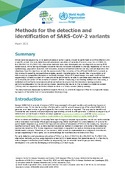Methods for the detection and identification of SARS-CoV-2 variants, March 2021

Download
Whole Genome Sequencing, or at least complete or partial S-gene, should be performed to confirm infection with a specific variant. For early detection and prevalence calculation of variants of concern (e.g. B.1.1.7/501Y.V1, B.1.351/501Y.V2, P.1/501Y.V3), alternative methods have been developed, such as diagnostic screening PCRbased assays. While testing strategies should be flexible and rapidly adaptable to change, depending on the local epidemiology, population dynamics and resources, sample and method selection are key and will depend on the objectives. Specific objectives include the assessment of the circulation of the different SARS-CoV-2 variants in the community selecting representative samples, genetic characterisation to monitor the virus evolution and inform vaccine composition decisions or outbreak analyses. When PCR-based assays are used, confirmatory sequencing of at least a subset of viruses should be performed to be able to use these assay results as indicators of community circulation of the variants of concern. Before introducing a new testing method or a new assay, a validation and verification exercise should be carried out to ensure that the laboratory testing system is performing adequately for the circulating viruses. Reporting the results to The European Surveillance System (TESSy) and the sequences to GISAID should be done in a timely manner (ideally weekly).
This document was developed by technical experts from ECDC and WHO Regional Office for Europe with review by experts of the SARS-CoV-2 Characterisation Working Group.



